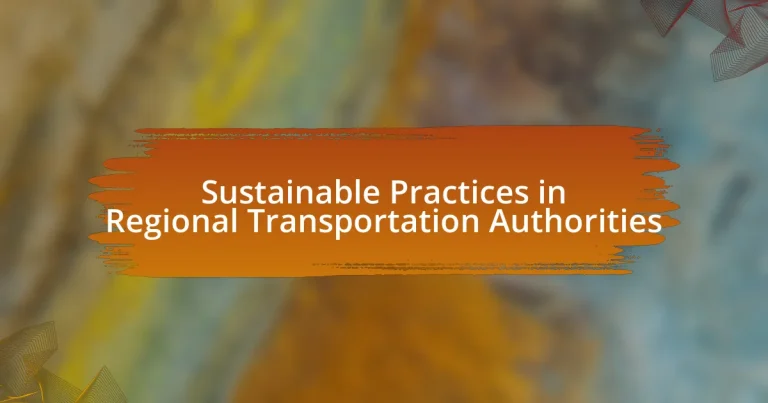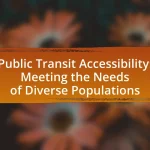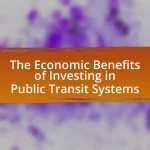Sustainable practices in regional transportation authorities focus on strategies that minimize environmental impact while improving mobility. Key initiatives include promoting public transit systems, which significantly reduce greenhouse gas emissions, and implementing bike-sharing programs and pedestrian-friendly infrastructure to encourage non-motorized transport. These practices address critical environmental issues such as air pollution and habitat disruption, while also enhancing public health and community well-being. Challenges such as funding limitations and regulatory constraints hinder the adoption of these practices, yet successful case studies demonstrate the effectiveness of collaborative efforts and innovative technologies in achieving sustainability goals.
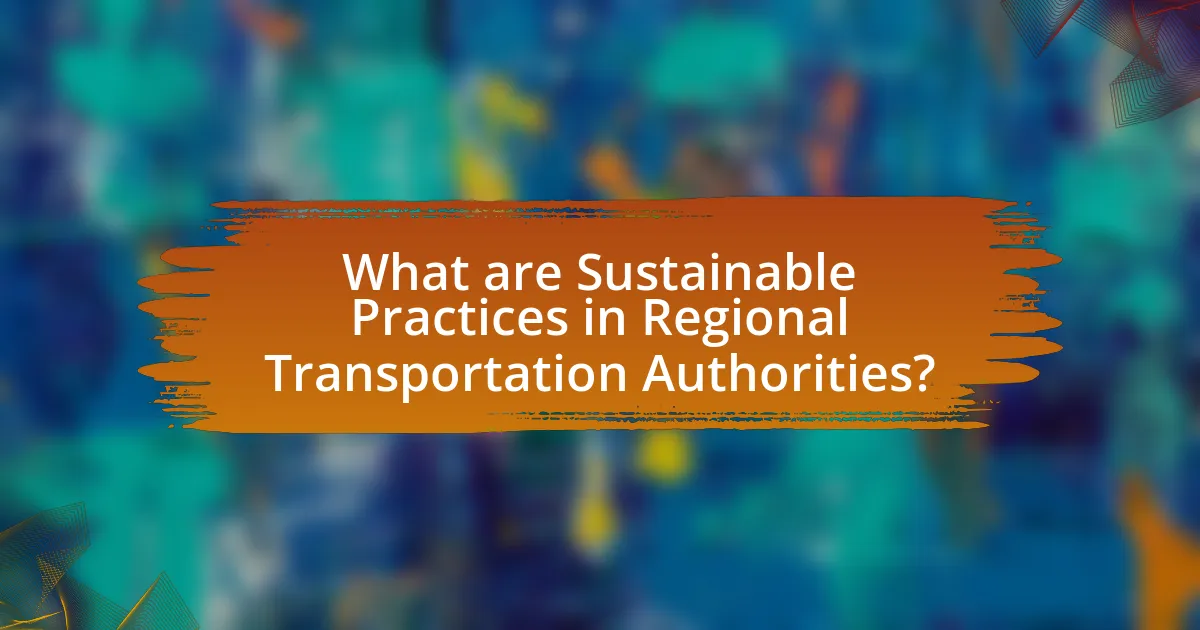
What are Sustainable Practices in Regional Transportation Authorities?
Sustainable practices in regional transportation authorities encompass strategies aimed at reducing environmental impact while enhancing mobility. These practices include the promotion of public transit systems, which can significantly lower greenhouse gas emissions per passenger compared to single-occupancy vehicles. For instance, the American Public Transportation Association reports that public transit saves approximately 45 million metric tons of carbon dioxide annually. Additionally, regional transportation authorities often implement bike-sharing programs and pedestrian-friendly infrastructure to encourage non-motorized transport, further contributing to sustainability goals. Moreover, the integration of electric and hybrid vehicles into public transit fleets reduces reliance on fossil fuels, aligning with broader climate action initiatives.
How do these practices contribute to environmental goals?
Sustainable practices in regional transportation authorities contribute to environmental goals by reducing greenhouse gas emissions and promoting energy efficiency. For instance, the implementation of electric buses and improved public transit systems decreases reliance on fossil fuels, leading to lower carbon footprints. According to the American Public Transportation Association, public transit use can reduce individual carbon emissions by 45% per mile. Additionally, initiatives such as bike-sharing programs and pedestrian-friendly infrastructure encourage alternative modes of transport, further decreasing vehicular emissions and promoting cleaner air quality. These practices collectively support the broader objectives of sustainability and climate action.
What specific environmental impacts are addressed by these practices?
Sustainable practices in regional transportation authorities specifically address air pollution, greenhouse gas emissions, and habitat disruption. These practices aim to reduce emissions from vehicles by promoting public transit, cycling, and walking, which collectively lower the carbon footprint associated with transportation. For instance, the implementation of electric buses can significantly decrease air pollutants, contributing to improved air quality. Additionally, initiatives such as the development of green infrastructure and the preservation of natural habitats mitigate the negative impacts of transportation projects on local ecosystems. According to the Environmental Protection Agency, transportation accounts for nearly 29% of total greenhouse gas emissions in the United States, highlighting the importance of these sustainable practices in combating climate change.
How do sustainable practices reduce carbon emissions in transportation?
Sustainable practices reduce carbon emissions in transportation by promoting the use of energy-efficient vehicles, enhancing public transit systems, and encouraging alternative modes of transport such as cycling and walking. For instance, the adoption of electric buses and hybrid vehicles significantly lowers greenhouse gas emissions compared to traditional diesel-powered options. According to the U.S. Environmental Protection Agency, transitioning to electric vehicles can reduce emissions by up to 50% over their lifetime. Additionally, improving public transit infrastructure can lead to increased ridership, which further decreases the number of individual car trips, thereby reducing overall emissions. Implementing policies that support cycling and walking not only cuts emissions but also promotes healthier lifestyles, contributing to a more sustainable urban environment.
Why are sustainable practices important for regional transportation?
Sustainable practices are important for regional transportation because they reduce environmental impact and promote economic efficiency. Implementing sustainable practices, such as using renewable energy sources and enhancing public transit systems, can significantly lower greenhouse gas emissions. For instance, a study by the American Public Transportation Association found that public transit saves approximately 45 million metric tons of carbon dioxide annually, highlighting the effectiveness of sustainable transportation methods in combating climate change. Additionally, sustainable practices can lead to cost savings for regional authorities by decreasing fuel consumption and maintenance costs, ultimately benefiting local economies and communities.
What role do these practices play in urban planning and development?
Sustainable practices in regional transportation authorities play a crucial role in urban planning and development by promoting environmentally friendly transportation options that reduce carbon emissions and enhance public health. These practices, such as the implementation of public transit systems, bike-sharing programs, and pedestrian-friendly infrastructure, contribute to more efficient land use and reduced traffic congestion. For instance, cities that invest in sustainable transportation options often see a decrease in vehicle miles traveled, which can lead to a reduction in greenhouse gas emissions by up to 45% in urban areas, as reported by the American Public Transportation Association. This shift not only supports economic growth by improving accessibility but also fosters community well-being by creating safer, more livable urban environments.
How do they enhance public health and community well-being?
Sustainable practices in regional transportation authorities enhance public health and community well-being by promoting active transportation options, reducing air pollution, and improving access to essential services. For instance, the implementation of bike lanes and pedestrian pathways encourages physical activity, which is linked to lower obesity rates and improved mental health. Additionally, transitioning to electric buses and optimizing public transit reduces greenhouse gas emissions, leading to cleaner air and decreased respiratory issues among residents. Studies have shown that communities with robust public transportation systems experience increased social equity, as they provide greater access to jobs, education, and healthcare, ultimately fostering a healthier population.
What challenges do regional transportation authorities face in implementing sustainable practices?
Regional transportation authorities face significant challenges in implementing sustainable practices, primarily due to funding limitations, regulatory constraints, and public resistance. Funding limitations hinder the ability to invest in green technologies and infrastructure, as many authorities rely on fixed budgets that do not account for the higher initial costs of sustainable projects. Regulatory constraints often complicate the adoption of innovative practices, as existing laws may not support new sustainable initiatives or may require lengthy approval processes. Public resistance can arise from a lack of awareness or understanding of the benefits of sustainable practices, leading to opposition against changes in transportation systems. These challenges collectively impede the progress towards more sustainable regional transportation solutions.
What financial barriers exist for adopting these practices?
Financial barriers for adopting sustainable practices in regional transportation authorities include high initial investment costs, ongoing maintenance expenses, and limited funding sources. The transition to sustainable technologies often requires significant capital for infrastructure upgrades, such as electric vehicle charging stations or renewable energy installations, which can strain budgets. Additionally, ongoing operational costs, including training personnel and maintaining new systems, can further deter adoption. According to a report by the American Public Transportation Association, 70% of transit agencies cite funding limitations as a primary obstacle to implementing sustainable initiatives, highlighting the critical need for increased financial support and innovative funding mechanisms to overcome these barriers.
How do regulatory frameworks impact the implementation of sustainability initiatives?
Regulatory frameworks significantly influence the implementation of sustainability initiatives by establishing guidelines, standards, and incentives that shape organizational behavior. These frameworks can mandate compliance with environmental standards, thereby compelling regional transportation authorities to adopt sustainable practices such as reducing emissions and enhancing energy efficiency. For instance, the Clean Air Act in the United States requires transportation agencies to develop plans that meet air quality standards, which directly drives the adoption of cleaner technologies and practices. Additionally, financial incentives provided through regulations, such as grants for electric vehicle infrastructure, encourage authorities to invest in sustainable solutions. Thus, the presence of robust regulatory frameworks not only sets the legal groundwork for sustainability initiatives but also motivates and facilitates their execution through compliance and financial support.

What strategies are employed by Regional Transportation Authorities to promote sustainability?
Regional Transportation Authorities employ strategies such as enhancing public transit systems, promoting active transportation, and implementing green technologies to promote sustainability. By improving public transit, authorities aim to reduce reliance on personal vehicles, thereby decreasing greenhouse gas emissions. For instance, cities like San Francisco have expanded their bus and light rail services, resulting in a significant increase in ridership and a reduction in traffic congestion. Additionally, promoting active transportation, such as biking and walking, is supported through the development of bike lanes and pedestrian-friendly infrastructure, which encourages healthier commuting options. Furthermore, the adoption of electric buses and energy-efficient technologies in transit operations exemplifies the commitment to reducing the carbon footprint of transportation services. These strategies collectively contribute to a more sustainable transportation ecosystem.
How do authorities integrate public transportation with sustainable practices?
Authorities integrate public transportation with sustainable practices by implementing strategies such as electrification of transit fleets, promoting multimodal transport options, and enhancing energy efficiency in operations. For instance, cities like Los Angeles have invested in electric buses, which reduce greenhouse gas emissions and improve air quality. Additionally, many authorities encourage the use of bike-sharing programs and pedestrian-friendly infrastructure to complement public transit, thereby reducing reliance on personal vehicles. According to the American Public Transportation Association, public transit use can reduce individual carbon footprints by up to 45% compared to driving alone. These measures collectively contribute to a more sustainable transportation ecosystem.
What types of public transportation options are considered sustainable?
Sustainable public transportation options include electric buses, light rail systems, and bicycle-sharing programs. Electric buses reduce greenhouse gas emissions and improve air quality, while light rail systems offer efficient mass transit with lower energy consumption per passenger compared to cars. Bicycle-sharing programs promote active transportation and decrease reliance on fossil fuels. According to the American Public Transportation Association, public transit saves 45 million metric tons of carbon dioxide annually, highlighting the environmental benefits of these sustainable options.
How do authorities encourage the use of public transportation over personal vehicles?
Authorities encourage the use of public transportation over personal vehicles by implementing policies that enhance accessibility, affordability, and convenience of public transit options. For instance, many cities have introduced subsidized fare programs, making public transport more financially attractive compared to the costs associated with owning and maintaining a personal vehicle. Additionally, the development of extensive transit networks, including bus rapid transit and light rail systems, improves connectivity and reduces travel times, which incentivizes commuters to choose public transport.
Moreover, authorities often invest in infrastructure improvements, such as dedicated bus lanes and transit-oriented developments, which facilitate easier access to public transportation. According to the American Public Transportation Association, communities that invest in public transit see a return of approximately $4 for every $1 invested, highlighting the economic benefits of promoting public transport. These strategies collectively aim to reduce traffic congestion, lower greenhouse gas emissions, and promote sustainable urban mobility.
What role does technology play in enhancing sustainable practices?
Technology plays a crucial role in enhancing sustainable practices by optimizing resource use and reducing environmental impact. For instance, smart transportation systems utilize real-time data to improve traffic flow, which decreases fuel consumption and emissions. According to a study by the International Transport Forum, implementing intelligent transport systems can reduce urban congestion by up to 30%, leading to significant reductions in greenhouse gas emissions. Additionally, electric and hybrid vehicles, supported by advancements in battery technology, contribute to lower carbon footprints in regional transportation. These technologies collectively foster more efficient, eco-friendly transportation solutions, aligning with sustainability goals.
How are smart technologies utilized in transportation systems?
Smart technologies are utilized in transportation systems through the integration of advanced data analytics, real-time monitoring, and automated processes to enhance efficiency and sustainability. For instance, smart traffic management systems use sensors and algorithms to optimize traffic flow, reducing congestion and emissions. According to a study by the Institute of Transportation Engineers, implementing adaptive traffic signal control can decrease travel times by up to 20% and reduce vehicle emissions by 10-15%. Additionally, smart public transportation systems utilize mobile applications for real-time tracking, improving user experience and encouraging public transit use, which contributes to lower carbon footprints.
What innovations are being adopted to improve energy efficiency?
Innovations being adopted to improve energy efficiency in regional transportation authorities include the implementation of electric and hybrid vehicles, smart traffic management systems, and the use of renewable energy sources for public transport. Electric and hybrid vehicles reduce greenhouse gas emissions and fuel consumption, with electric buses showing a reduction of up to 70% in energy use compared to traditional diesel buses. Smart traffic management systems optimize traffic flow, reducing idle times and emissions, while integrating renewable energy sources, such as solar panels at transit stations, further enhances sustainability by decreasing reliance on fossil fuels. These innovations collectively contribute to significant energy savings and a reduction in environmental impact.
How do regional transportation authorities engage with the community on sustainability initiatives?
Regional transportation authorities engage with the community on sustainability initiatives through public outreach programs, stakeholder meetings, and collaborative projects. These authorities often conduct surveys and workshops to gather community input on proposed sustainability measures, ensuring that local needs and preferences are considered. For example, the Metropolitan Transportation Authority in New York has implemented community engagement strategies that include public forums and online platforms to discuss sustainability goals, such as reducing greenhouse gas emissions and promoting public transit use. This approach not only fosters transparency but also builds trust and encourages community participation in sustainability efforts.
What methods are used to educate the public about sustainable transportation options?
Public education about sustainable transportation options is primarily achieved through community outreach programs, informational campaigns, and partnerships with local organizations. Community outreach programs often include workshops and events that engage residents directly, allowing them to learn about sustainable practices in an interactive setting. Informational campaigns utilize various media channels, such as social media, brochures, and public service announcements, to disseminate information about the benefits and availability of sustainable transportation options. Partnerships with local organizations, such as schools and environmental groups, enhance the reach and effectiveness of these educational efforts by leveraging existing networks and resources. These methods collectively aim to raise awareness and encourage the adoption of sustainable transportation practices within communities.
How do authorities gather community feedback to improve sustainability efforts?
Authorities gather community feedback to improve sustainability efforts through surveys, public meetings, and online platforms. These methods allow for direct engagement with community members, enabling authorities to collect diverse opinions and suggestions regarding sustainability initiatives. For instance, a study by the National Academy of Sciences found that public engagement through surveys can increase community support for sustainability projects by 30%. Additionally, online platforms facilitate broader participation, allowing authorities to reach a larger audience and gather real-time feedback, which is crucial for adapting and enhancing sustainability strategies effectively.
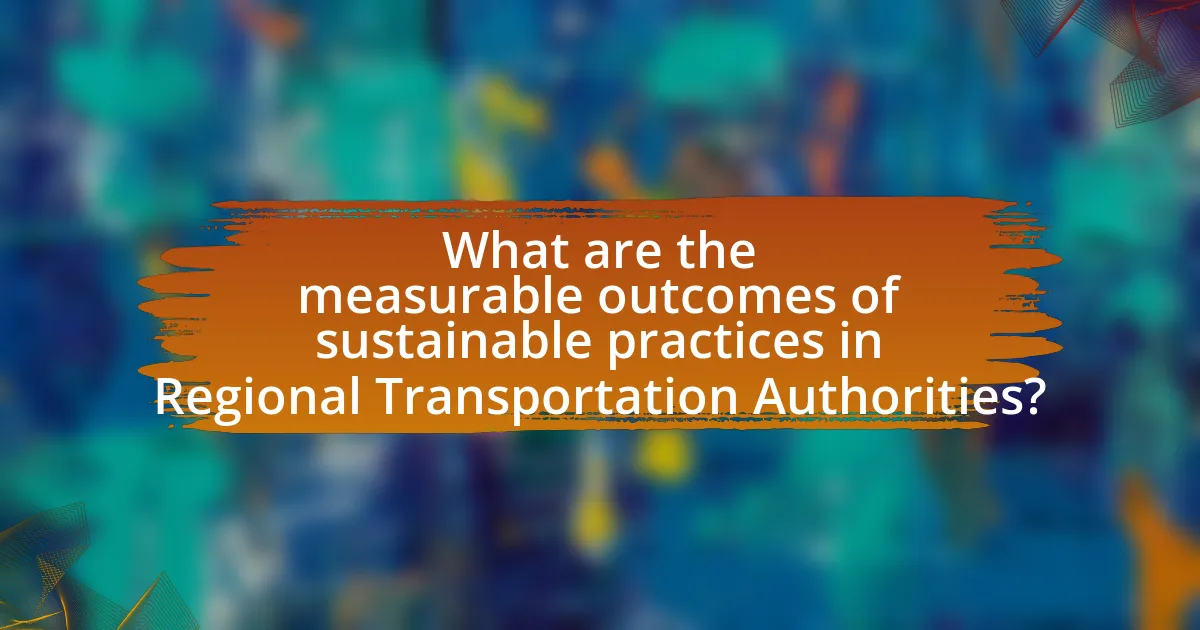
What are the measurable outcomes of sustainable practices in Regional Transportation Authorities?
The measurable outcomes of sustainable practices in Regional Transportation Authorities include reduced greenhouse gas emissions, increased public transit ridership, and improved air quality. For instance, implementing energy-efficient technologies and promoting public transit can lead to a significant decrease in carbon emissions; studies show that public transit produces, on average, 45% less carbon dioxide per mile than private vehicles. Additionally, cities that invest in sustainable transportation options often see a rise in ridership; for example, the implementation of bike-sharing programs and electric buses has been linked to a 20% increase in public transit use in various metropolitan areas. Improved air quality metrics, such as lower levels of particulate matter and nitrogen oxides, are also observed in regions that adopt sustainable practices, contributing to better public health outcomes.
How is the success of sustainability initiatives evaluated?
The success of sustainability initiatives is evaluated through a combination of quantitative metrics and qualitative assessments. Key performance indicators (KPIs) such as reductions in greenhouse gas emissions, increases in energy efficiency, and improvements in public transportation ridership are commonly used to measure effectiveness. For instance, a study by the American Public Transportation Association found that public transit systems can reduce individual carbon footprints by up to 45% compared to driving alone. Additionally, stakeholder feedback and community engagement surveys provide qualitative insights into the perceived impact of these initiatives. This dual approach ensures a comprehensive evaluation of sustainability efforts within regional transportation authorities.
What metrics are used to assess environmental impact?
Metrics used to assess environmental impact include carbon footprint, water usage, waste generation, and biodiversity loss. Carbon footprint measures greenhouse gas emissions, typically expressed in CO2 equivalents, providing a clear indication of an entity’s contribution to climate change. Water usage quantifies the volume of water consumed, highlighting the sustainability of water resources. Waste generation tracks the amount of waste produced, emphasizing the efficiency of resource use and waste management practices. Biodiversity loss metrics assess the impact of activities on ecosystems and species, often measured through indicators like species extinction rates or habitat degradation. These metrics are essential for evaluating the environmental performance of transportation authorities and guiding sustainable practices.
How do authorities track improvements in public transportation usage?
Authorities track improvements in public transportation usage primarily through data collection methods such as ridership surveys, automated fare collection systems, and GPS tracking of transit vehicles. These methods provide quantitative data on passenger numbers, travel patterns, and service efficiency. For instance, automated fare collection systems can generate real-time data on the number of passengers using specific routes, allowing authorities to analyze trends over time. Additionally, ridership surveys can capture user satisfaction and demographic information, which helps in understanding the factors influencing public transportation usage. Studies have shown that cities implementing these tracking methods have seen measurable increases in ridership, with some reporting up to a 20% increase in usage after service improvements based on data analysis.
What case studies exemplify successful sustainable practices in regional transportation?
Successful sustainable practices in regional transportation are exemplified by the case studies of Portland, Oregon, and Copenhagen, Denmark. Portland has implemented a comprehensive light rail system and extensive bike lanes, resulting in a 20% reduction in greenhouse gas emissions from transportation since 1990. Copenhagen has invested in cycling infrastructure, leading to 62% of its residents commuting by bike daily, significantly lowering carbon emissions and improving air quality. These case studies demonstrate effective strategies in reducing environmental impact while enhancing urban mobility.
What lessons can be learned from successful implementations in various regions?
Successful implementations in various regions demonstrate that collaboration among stakeholders is crucial for effective sustainable practices in transportation. For instance, the integration of public-private partnerships in cities like Amsterdam has led to significant investments in cycling infrastructure, resulting in a 38% increase in cycling rates over a decade. Additionally, data from the California Air Resources Board shows that regions adopting comprehensive transit-oriented development strategies have reduced greenhouse gas emissions by up to 30%. These examples highlight the importance of stakeholder engagement and strategic planning in achieving sustainability goals in transportation.
How do these case studies inform future sustainability strategies?
Case studies inform future sustainability strategies by providing empirical evidence of successful practices and their outcomes. For instance, a case study on a regional transportation authority that implemented electric buses demonstrated a 30% reduction in greenhouse gas emissions compared to traditional diesel buses. This data supports the adoption of similar electric vehicle initiatives across other regions, showcasing the potential for significant environmental benefits. Additionally, these case studies highlight the importance of stakeholder engagement and community feedback in developing effective sustainability strategies, as seen in a case where public input led to the optimization of transit routes, increasing ridership by 15%. Such insights guide future planning and policy-making, ensuring that sustainability strategies are both effective and aligned with community needs.
What best practices can be adopted by other authorities looking to implement sustainability?
Authorities looking to implement sustainability should adopt best practices such as integrating public transportation systems, promoting active transportation modes like cycling and walking, and utilizing renewable energy sources. For instance, cities that have invested in comprehensive public transit networks, such as Portland, Oregon, have seen a significant reduction in greenhouse gas emissions, with a reported 30% decrease since 1990 due to increased public transit usage. Additionally, implementing policies that encourage mixed-use development can reduce reliance on cars, as evidenced by studies showing that walkable neighborhoods lead to a 20-40% decrease in vehicle miles traveled. Furthermore, authorities should prioritize stakeholder engagement and community involvement in sustainability planning, which has been shown to enhance project success rates and public acceptance.
What are the key steps for initiating sustainable practices in transportation?
The key steps for initiating sustainable practices in transportation include assessing current transportation systems, setting clear sustainability goals, engaging stakeholders, implementing eco-friendly technologies, and monitoring progress. Assessing current systems involves evaluating existing infrastructure and identifying areas for improvement, which provides a baseline for future initiatives. Setting clear sustainability goals, such as reducing greenhouse gas emissions by a specific percentage, guides the direction of efforts. Engaging stakeholders, including local communities and businesses, ensures that diverse perspectives are considered and fosters collaboration. Implementing eco-friendly technologies, such as electric buses or bike-sharing programs, directly contributes to sustainability. Finally, monitoring progress through data collection and analysis allows for adjustments and demonstrates accountability, ensuring that the practices remain effective and aligned with established goals.
How can regional transportation authorities collaborate for greater impact?
Regional transportation authorities can collaborate for greater impact by sharing data and resources to enhance service efficiency and sustainability. By establishing joint initiatives, such as coordinated transit schedules and integrated fare systems, authorities can reduce redundancy and improve user experience. For instance, the Metropolitan Transportation Authority in New York collaborates with neighboring transit agencies to streamline operations, resulting in increased ridership and reduced environmental impact. This collaborative approach not only maximizes resource utilization but also fosters innovation in sustainable practices, as seen in successful partnerships like the Bay Area Rapid Transit and local bus services, which have implemented eco-friendly technologies and shared infrastructure projects.
